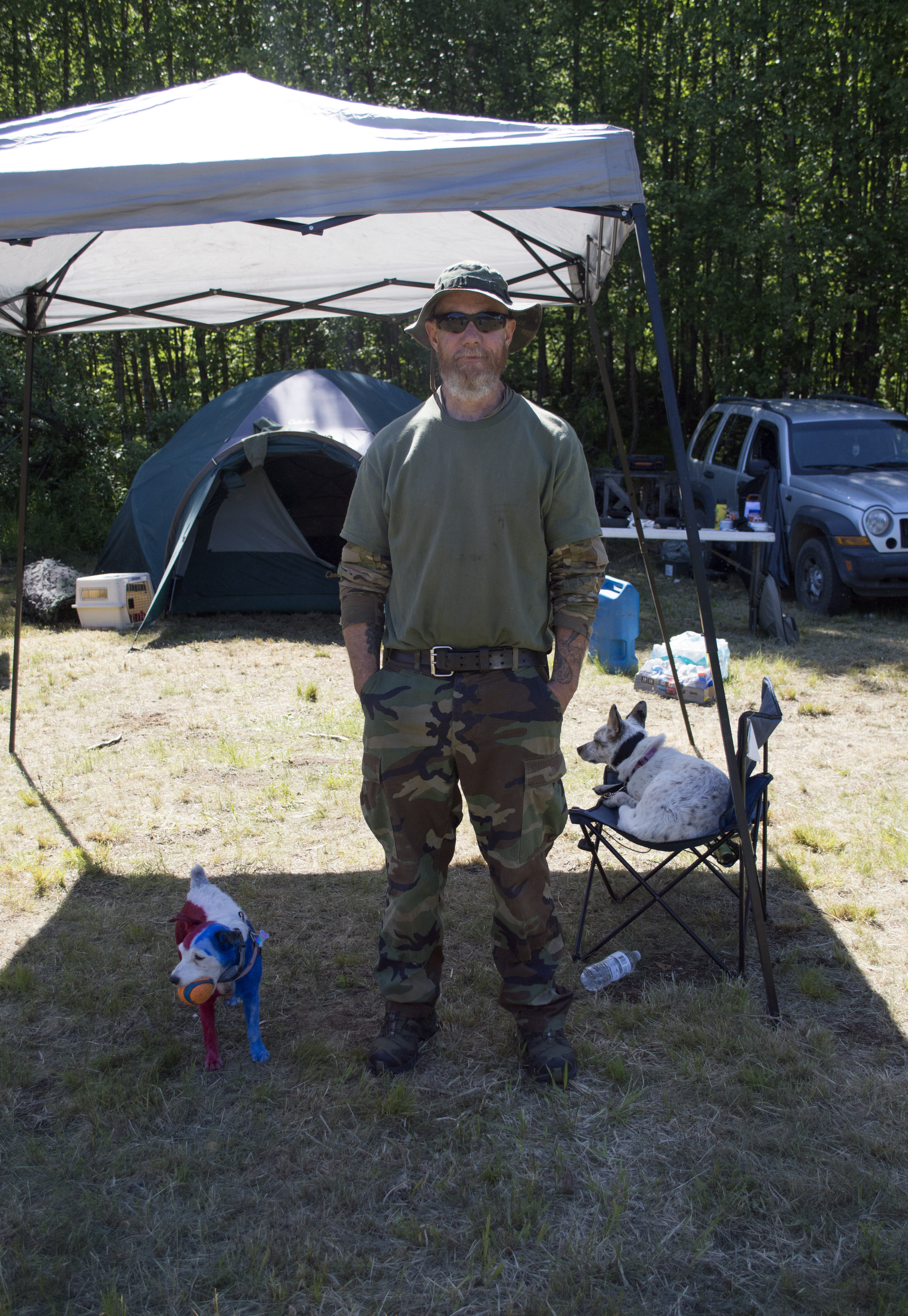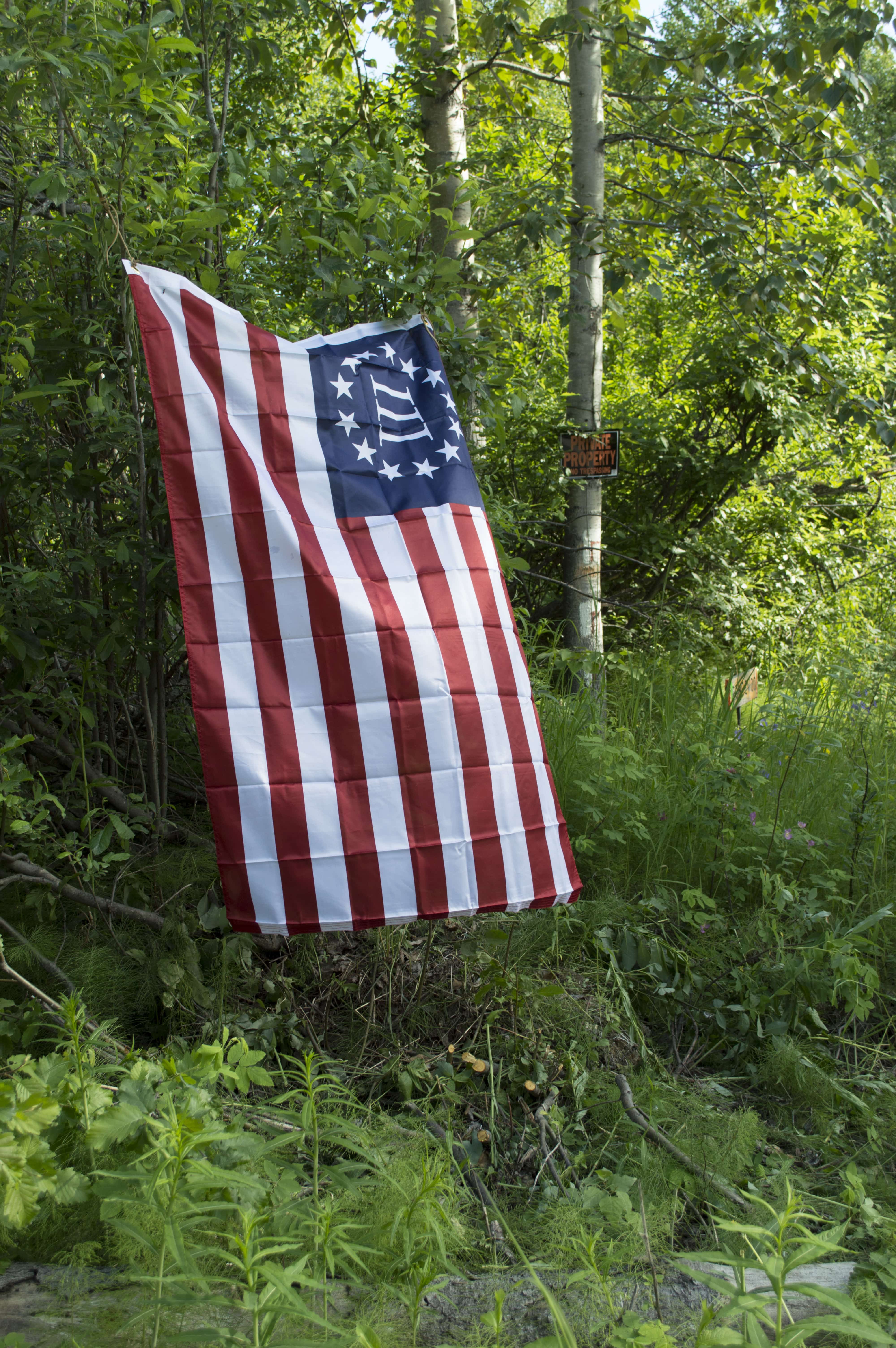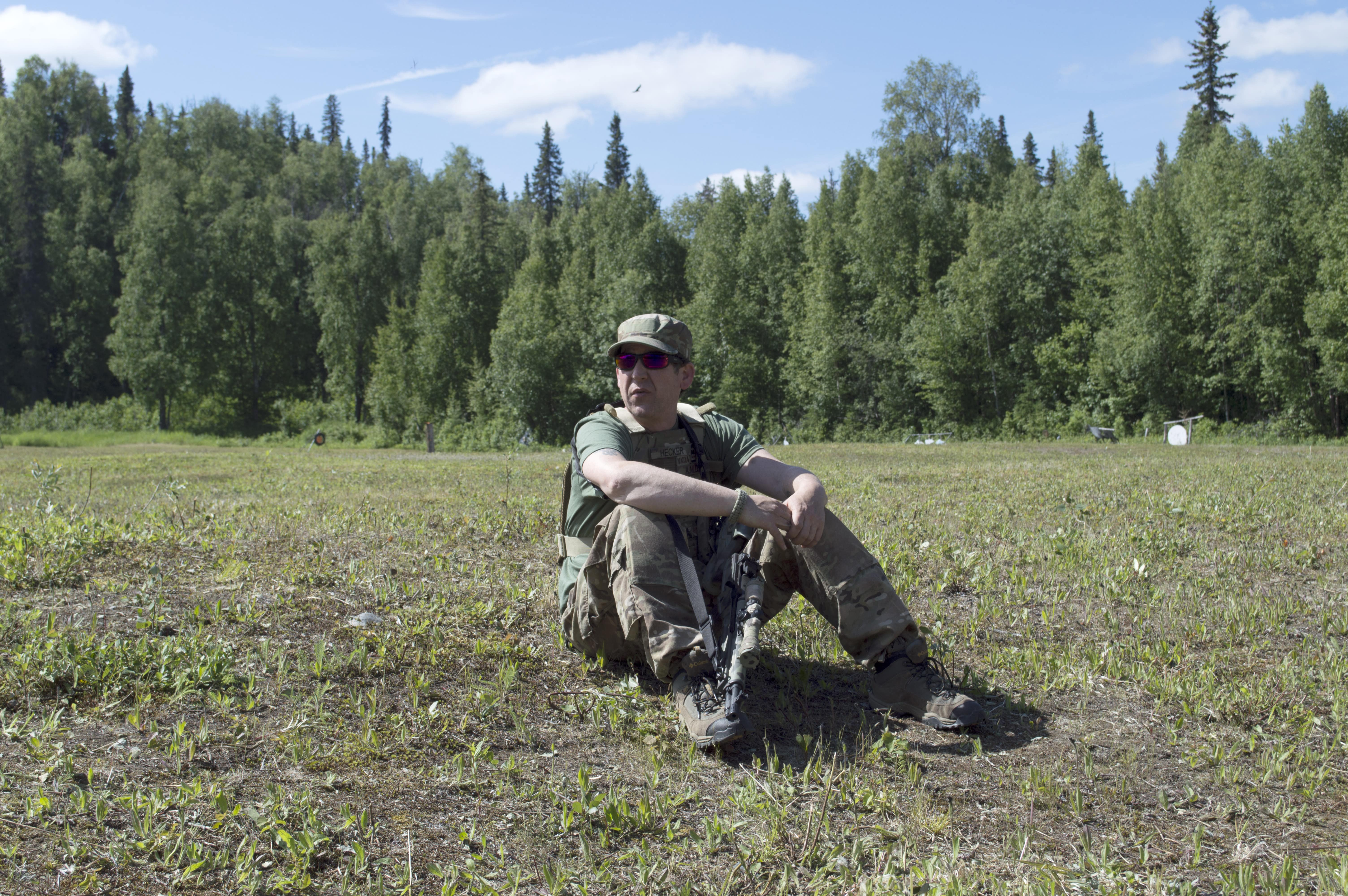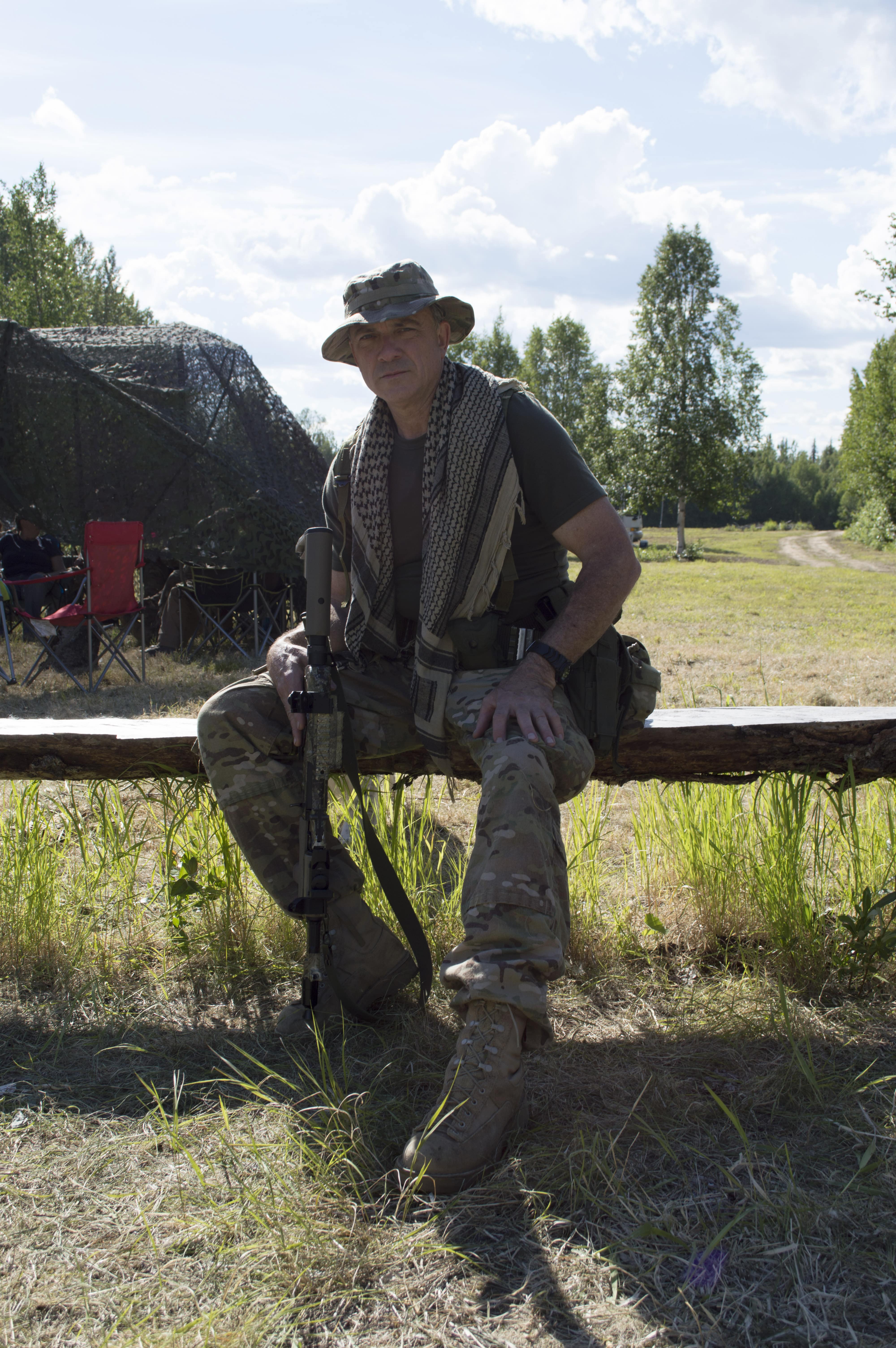Benefit or Burden? Alaska Militias Prep for Inevitable Challenges, Worst Case Scenarios
At the 2017 Prepper, Survivalists and Militia Rendezvous in Talkeetna, Alaska—Rondy for short—a number of people stroll the backcountry property with handguns holstered on their hips or legs, rifles slung across their shoulders.
There are dogs and tents and motorhomes, classes and discussions on subjects like self-defense and ham radios, a community campfire and a firing range. Anyone is free to attend. According to the local militia leaders at Rondy, transparency is important because the militia movement in Alaska is nothing like its Lower 48 counterparts.
Standing at maybe five-foot-seven, bearded and decked out in camo, John Root, III, founder of South Central Patriots (SCP), can be a man of few words. It might take him a minute to size you up, but once he does, he’ll level with you on what makes Alaska stand out.
“[SCP] is more of a libertarian thing,” Root says, “Everybody’s free to do whatever. Nobody steps on anybody’s toes.”
Root formed SCP in 2008. It was 25 degrees below zero in the Matanuska-Susitna Valley the day it started, with three people huddled around a woodstove in a garage.
Since then, SCP has expanded to towns large and small across Alaska, a state with a total population of less than 740,000 people. They have members in Anchorage, Fairbanks, Delta Junction, the Kenai Peninsula. They have guys in Dillingham, Juneau and Ketchikan, too. Today, it’s arguably the largest homegrown militia group in Alaska.
Standing near the Rondy community campfire, Root looks at his iPhone and estimates that he associates with “probably a thousand [local] people. I go through my phone and what’s really weird is I’ve met hundreds and hundreds of them … and we’re all of the same mindset.”
Root says national groups like APIII, Watchmen, Guardian Angels, Soldiers of Odin and Oath Keepers can rely on each other down in the contiguous United States—“they can get to their neighbors, they can get across state lines,” he says, his Jack Russell Terrier nearby sporting a red, white and blue hairdo—but if something happens in Alaska, those groups can’t be relied on.
“All of these groups are alright in the Lower 48, but as soon as they come up here, they try to tell me that I gotta hand all these people over to them,” says Root, lifting his hand and extending his middle finger. “And this has happened several times with these national groups and I tried to tell these guys, I say, ‘you know, when something happens, we’re on our own [in Alaska]. That’s just how it is.’”
Root says he first ran into a guy from Oath Keepers back in 2013 during a food storage class SCP was hosting. He says the guy was wearing an Oath Keepers’ shirt, “looked all preppy” and was trying to poach SCP members; military and ex-military, registered nurses, airplane mechanics, anyone with refined skills.
“[The Oath Keepers] say, ‘once everything gets created, we’ll come see you,’” Root says. “[I say], ‘I don’t want you down my driveway and I won’t come down your driveway.’ I mean, if I don’t know you and we haven’t had a face to face and we ain’t been able to sit down and have dinner and talk and visit, don’t come down my driveway.”
Oath Keepers, founded in 2009 by Elmer Stewart Rhodes, claim to have 30,000 members in chapters across the United States. Members of Oath Keepers have shown up to protests openly carrying firearms and have been accused of racism.
Rhodes has a history of incendiary comments. In 2014, he called John McCain a traitor and suggested that he should be tried for treason.
“[McCain] would deny you the right for trial to jury, but we will give him a trial for jury,” Rhodes said, “and then after we convict him, he should be hung by the neck until dead.”
In a 2016 interview on the Alex Jones show, Rhodes endorsed an Islamophobic essay by Matthew Bracken and spoke about how the government is responsible for a “fourth generation warfare, assault on this country, just as they’re doing on Europe.”
“It’s an assault on Western civilization,” Rhodes said. “The wide-open borders in Europe, the obvious ‘Tet Two,’ as Matt Bracken calls it, I think he’s right. They’re intentionally leaving the borders open in Europe, bringing in mass refugees, among them are going to be jihadists, who are setting up a future Tet offensive, Tet style offensive, in Europe and the same thing is being done in this country.”
According to SPLC reporting, there are currently zero hate groups in Alaska. There are, however, 10 antigovernment groups, which, given the state’s small population, is a fairly large amount.
While militia groups in other states have a history of antigovernment rhetoric and domestic terrorism, the militia groups at this year’s Rondy say they are more preoccupied with self-reliance and preparing for natural disasters.
The sixth annual Rondy took place on the weekend of June 23, 2017. SCP, the Anchorage Municipal Defense Force and Anchorage Citizen’s Militia were among the groups in attendance. The event is described on its Facebook page as an annual gathering of likeminded folk for the purpose of networking, training and trading. The property Rondy sits on, roughly 113 miles north of Anchorage, is a 51-acre piece of land owned by Ed Wick, an amiable, giant of a man who’s missing one of his front teeth and a couple in the back.
“[It’s a] great bunch of people from all walks of life,” he says of the attendees. “We got retired military, I think we even got a couple guys that are probably still in the Guard, you can see wives and kids… If there was ever a severe emergency situation, like a very bad earthquake or something of that nature, these people would support law enforcement. They’d be an auxiliary type thing.”
Near Anchorage Municipal Defense Force founder Rick Ford’s campsite three rifles lean against the bumper of a pickup. A rifle, a SOCOM 16, hangs across Anchorage Citizen’s Militia founder Eric Hecker’s back.
The relationship between the militia lifestyle and firearms, Hecker says, is inherent to the Constitution and the Second Amendment, and that the ability to defend yourself, with a weapon, is integral to life, liberty and the pursuit of happiness.
“The only way to defend yourself would be through some sort of weapon,” he says, “unless you’re a ninja. Feel free to beat people up if they come after you. If they want to punch you and you can punch them, cool. If they have a gun and you still want to punch them, that’s your choice. Welcome to freedom.”
Hecker adds that, for most people, the word “militia” has a negative connotation because there has been an intent for it to be understood that way. However, he says that was not the intention of the founding fathers.
“When our founding fathers put pen to paper,” Hecker says, “they clearly define it at that time…”
“ … If you read the Constitution,” interjects Ford, “if you understand where their mindset was, there is no question as to what the citizen’s responsibility is. It’s pretty clear.”
When asked how he gets past the negative perception of militia groups—that their philosophy is based on a history of violence and that their antigovernment rhetoric is fueled by paranoia—Root says that he would prefer that people don’t compare SCP, or affiliated Alaska militias, with other militia groups, and that they should be judged by the merits of their own actions and words.
“Simply put, we would ask [people who judge us] to practice what they preach,” Root says. “If they have not attended one of our events or spoken to our people, then they do not know anything about us and their words would slide off like water on a duck’s back. We will move forwards, like we do each and every day, to assist each other no matter what the naysayers believe to be true.”
Newcomers to Alaska’s militia scene may have other ideas. In 2009, the co-founder of the Michigan Militia, Norman Olson, moved to Alaska. That same year, he held a recruitment speech in the small town of Nikiski, Alaska, about 170 miles south of Anchorage.
At the meeting, Olson warned attendees, “we’re looking at catastrophe just a couple months away—economic collapse, food shortages around the world, prices in stores are gonna go skyrocketing with this inflation.”
Back near the Rondy community campfire Root mentions the notorious Olson.
“He’s a very smart dude,” Root says, “and [he said] there was three things that we had to watch out for and that’s moles, provocateurs and dissipaters. [The Oath Keepers] are dissipaters, they’re trying to come in and take and just break apart [what we] started.”
At its height, the Michigan Militia claimed to have 10,000 members. However, after the Oklahoma City Bombing, orchestrated by Timothy McVeigh and Terry Nichols—both are suspected of having attended a Michigan Militia meeting prior to the attack—the Michigan Militia all but dissipated. Olson’s bizarre statement to news agencies just after the 1995 attack —in which he claimed that Japan was actually responsible for the Oklahoma City bombing in retaliation for nerve gas attacks on subways in Tokyo — led to his resignation
There is a distinct difference in the militia movement in Alaska and that of the Lower 48, and that kind of wild conspiratorial talk doesn’t translate well to the Last Frontier, where they’ve got things closer to home to worry about. “The militia movement, for us, is a lifestyle,” Hecker says. “It is not a weekend warrior type of thing … We know no one’s coming to help us, unlike any state in the Lower 48 that borders assistance.”
Hecker, like others in the movement, believe that in the event of a natural disaster, invasion or total collapse of government, no one is coming to help. So, while other militia groups in the Lower 48 are concocting theories about a totalitarian government takeover or looking to the skies for black helicopters, Alaska militias are busy preparing for natural disasters.
“I guess we would like to say we’re a little bit more realistic,” he says.
Hecker references a cheatsheet.com article he posted on Facebook titled The Most Dangerous States in America in 2017.
“Alaska is ranked number one, with Anchorage showing up very high as being wildly violent,” he says, “and I agree with that. It’s great. I love it because freedom is dangerous. So, the fact that we show up as the most dangerous place to be is really screaming that we’re also the most free.” The appeal of Alaska is freedom, he says, which is also key to the militia movement.
Alaska militia groups are inherently more independent than militia groups in the Lower 48, says David Luntz three weeks after Rondy. Luntz was the founder of the Central Alaska Militia until it folded early last year, and now acts as a point of contact for public relations, recruitment and group coordination for militia groups throughout Alaska.
He recruits by putting people in contact with the group closest to them. If no group exists, then Luntz encourages the recruit to start their own. He says that he is the lead point of contact for Oath Keepers and national Three Percenter groups in Alaska.
Although Luntz says he doesn’t particularly like working with national groups, he says it’s necessary for three main reasons: to imitate success, identify what doesn’t work and for intel on current events.
“[Staying in contact with national groups does] lend a level of coordination, intel and awareness of what’s going on in the Lower 48,” he says.
As to their difference, he says, “[Groups in the Lower 48] focus on building state-level or national-level groups, whereas Alaska groups focus more [on] the local-level. The groups across [Alaska] place emphasis more on self-sufficiency because that is our highest threat regardless of natural disaster or [a] manmade threat.”
In 1964, a 9.2 earthquake caused massive structural damage throughout southcentral Alaska. It lasted four minutes and 38 seconds, induced ground fissures, tsunamis, widespread power outages, $311 million in damage and the deaths of about 139 people. Anchorage—Alaska’s largest city—sustained most of the damage. It is the second largest earthquake ever recorded and Alaskans weren’t ready for it.
That scenario, and the possibility of it happening again, is one reason for Alaska-based militia groups to prepare.
“If the earthquake of ‘64 were to happen tomorrow, in your neighborhood, would you be a hindrance to your neighbors, would you be a burden, or would you be helpful to them?” Hecker asks.
“If you find that you would be a burden to your neighbors, you should join the militia. If you find that you would be able to help your neighbors, you should also join the militia because you should be training for that day now. We’re in Alaska, we already know that day’s coming … You’re either going to be a benefit or a burden.”
This story was updated on July 26, 2017.





